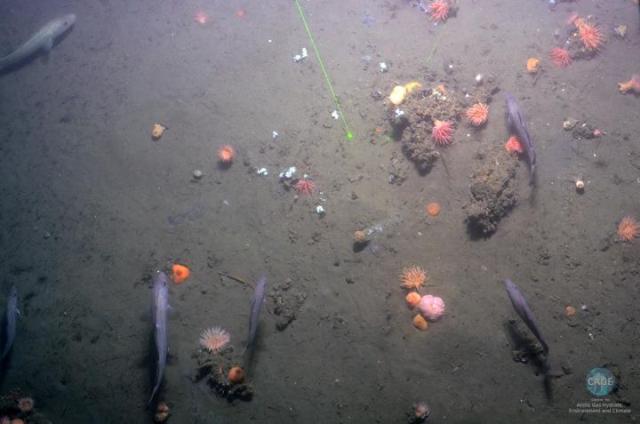Jun 29 2015
Over a course of 12 days Dr. Giuliana Panieri and her colleagues from Centre for Arctic Gas Hydrate, Environment and Climate (CAGE) collected images from seven areas of known methane release in the Arctic Ocean. One of them was Vestnesa Ridge, with over 1000 active seep sites at the depth of over 1000 m.
 Arctic seafloor at 500 meters water depth. Carbonate blocks are colonized by anemones and sponges. Tube worms are abundant at the seafloor. In the upper part of the image, we see patches of bacterial mats. All of these features are indigenous to sites of methane release. Schools of codfish appeared to be following the laser beams from the camera system. Fish were often observed in big quantities during the cruise. Credit Courtesy of CAGE/UiT
Arctic seafloor at 500 meters water depth. Carbonate blocks are colonized by anemones and sponges. Tube worms are abundant at the seafloor. In the upper part of the image, we see patches of bacterial mats. All of these features are indigenous to sites of methane release. Schools of codfish appeared to be following the laser beams from the camera system. Fish were often observed in big quantities during the cruise. Credit Courtesy of CAGE/UiT
Methane is a potent greenhouse gas stored in the ocean floor in unknown quantities. CAGE is a centre dedicated to assessing the amount of methane stored in these reservoirs, and what impact the methane in the Arctic Ocean may have for ocean environment and climate change. Main focus of the research is gas hydrate, a methane trapped in a solid structure that resembles ice.
Panieri collaborated with scientists and engineers at Woods Hole Oceanographic Institution's MISO Deep-Sea Imaging Facility. The aim was to get a proper view of the deep Arctic Ocean floor.
"We have taken so many samples all over these areas, but we were sampling blind. We needed to see what was going on down there." says Panieri who is an awe of the results achieved during the two-week cruise.
The system that was used to get these images is based on the 'TowCam' design developed by WHOI scientists and engineers, and funded by the U.S. National Science Foundation. It consists of a color still camera that takes images every 10-15 seconds.
"This is the first time that we have seen these methane seeps in the deep Arctic Ocean areas. The images are amazing." says Panieri.
The midnight sun allowed for the tow cam system to be deployed 24/7 providing scientist with data that will be crucial in new discoveries in years to come.